
Exhibitions: Current | Upcoming | Past
Exhibitions: Past
Simultaneity
Works by Meghan Brady, Nick Lamia, Steve McCall, Gabriel Phipps, and Dannielle Tegeder
January 24 – February 22, 2013
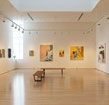

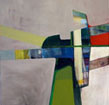
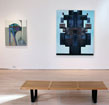

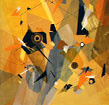
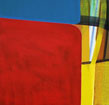
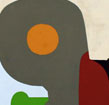
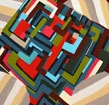
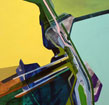


Simultaneity is a term defining the phenomenon of relative perspectives or points of view in relation to a singular event or occurrence. You and I might witness the same event at the same time, but our frames of reference determine our perception of the experience.
Even if our positions are close to each other, it is impossible for us completely agree on some aspects of what we have both witnessed.
In the drawing studio, for example, students drawing from a still life in the middle of the room are often surprised to discover how different the compositions of the work of their classmates are on the other side of the room.
To take this even further, the notions of pictorial space are dictated by a series or set of rules that we learn to apply to a 2-dimensional space; vertical and horizontal lines define the edges of forms and diagonal lines describe depth.
But if we apply multiple points of view, or frames of reference, on the same two dimensional plane — for example, if we draw 2 separate but overlapping compositions on the same surface - there may be a series of new configurations or associations that are now possible.
Parts of this same drawing may be read with sharp pictorial clarity while other areas may fall into a series of elements that create/describe ambiguous, arbitrary or conflicting space.
The artists in this exhibition explore some of these ideas throughout their works. Collectively, they have written about the notions of simultaneity as visually rich experiences coupled with conflicting and multiple perspectives.
As such, the resulting images are not descriptions of the world from a single point of view — but singular compositions that contain a multitude of visual references that refer to many ideas about representation.
"We collectively define simultaneity as a viewing experience rich in associations and visual phenomena — a pool of conflicting sources and viewpoints that only make sense together in a fictional world.
Peculiar and often tense combinations include subjects seen from multiple perspectives; forms that function as windows; objects whose scale vacillates between human-size and the infinite; paint that describes pictorial space while asserting
itself in literal space; forms that are at once synthetic and organic; solid and ephemeral, static and kinetic. "
They also acknowledge their debts to cubism and early 20th century ideas of managing or fragmenting pictorial space as a way to rethink and define the ordinary, the familiar.
Yet these works are not an homage to cubism any more than they are about revisiting other painting genres or styles. Rather, they freely borrow those ideas which are relevant to each individual path.
And from that perspective, a new and relatively singular point of reference is made.
Kathleen Hancock
Director
Artists
Meghan Brady
My paintings usually evolve from several series of collages and drawings. I employ wide-ranging materials in the collages, creating my own sense of order, pattern, and color.
While painting, I find I am in a constant back and forth with the piece. Sometimes I'm telling the painting where to go while, other times, the painting is telling me what to do. I'm interested in rough geometry, points of intersection, and a loose, shifting kind of symmetry.
I'm aware of the canon of art history but find great inspiration in the so-called "Outsiders." I would never paint directly from an old quilt or a hand dyed rug but I see great beauty in both.
Ultimately, I aim to get each painting to a logical place at which the color, scale shift, and structure are just right for that particular canvas. I never know how or when I will arrive but I trust the process.
Nick Lamia
Facing south on the corner of 84th Street and 5th Avenue in Manhattan, the woods and lakes of Central Park are on your right, and on your left, rows of buildings march downtown. Straight ahead, bridging the two distinct landscapes is the Metropolitan Museum. At that intersection art unites nature with society the way I do in my imagery.
My interest in unifying nature and society comes from life experience. I've lived in cities mostly, but I also spent years in the wilderness of the Sierra Nevada and on the ocean as an offshore expedition leader. Such varied circumstances taught me that despite the perceived separation between society and nature, they are really complementary parts of a single system and though we may never fully understand their juncture, we must integrate them to thrive as a species.
My artworks are embodiments of this integration, and despite the abstract appearance of my imagery, my practice is rooted firmly in the plein-air landscape tradition. Like the Hudson River School painters before me, I am interested in focusing on nature as something to be revered and embraced, rather than something to be exploited or feared. Linear, diagrammatic structures mixed with planes of color render partial views, or fragmentary maps of imagined spaces, both miniscule and vast, where nature and technology meet. Contrast among my forms and counterintuitive color combinations are metaphors for a world where technology and ecology are in symbiosis despite their difference.
Steve McCall
My paintings are rooted in experience; how experience is – in essence – change over the course of time. They arise from observable and conceptual phenomenon. The work comes out of natural cycles of growth, decay and regeneration and the human cultural response to these cycles — especially within the context of the contemporary urban environment, the dichotomy of human culture and an independent natural life. I see such changes as dynamic forces in flux, at different rates of ebb and flow. The paintings then are about human reaction to change as much as they are about observable phenomenon in nature. They congeal as iconic pictures both from memory and from ideation.
I paint in groups, working on the same composition or organizational idea so that the paintings inform each other and work back and forth enabling them to expand beyond or abandon their original parameters. Drawing from life, I work through sketchbooks in a serial manner to generate different compositional ideas and relationships. That is how one abstracts and internalizes experience and this is what I do with painting. At the group painting stage, I see how formal relationships grow and change through the course of working. Both color and form can either be referential or act in terms of the picture's own internal structure. Through a combination of hard-edged and biomorphic abstraction I construct a pictorial architecture that emphasizes formal relationships. This involves drawing on and scraping away layers of paint, where I incur in myself a responsive flexibility. The work is complete when the painting exhibits its own psychological independence, when it "looks back" at the viewer by projecting its pictorial energy out into the space around it. The intent of this work then is for the viewer to experience change through a visceral, physical encounter with the painting.
Gabriel Phipps
A great teacher of mine once said paint can be anything, a sentiment I very much agree with. I might add that paint can be everything — at once.
Through the use of basic geometric shapes — squares, rectangles and trapezoids — I make paintings that simultaneously reference a number of visual notions and phenomena. Architectural forms derive from rectangularly shaped painting media and are a response to the urban landscape in which I live. Color combinations reference the elements – water, earth, sky, and fire – while also referring to digital light, the vibrant blue of a computer desktop, and childhood memories of Boston's brick cobbled streets and buildings. Figurative content speaks to the experience of confronting somebody within the confines of a rectangle, be it a doorway or a mirror. Pressurized junctions of form, and subsequent deformations of shape, are a nod to aerial photography and environmental forces acting on one another.
Laden with contradictory source material, the geometric units that reverberate throughout the work are at once flat and volumetric, solid and ephemeral, synthetic and organic, static and kinetic, fictitious and real; they are structures seen from above and from the ground; they are free-standing and verge on collapse; they speak of pink flesh, metal shards and glowing television screens; they are somebody who is nobody, someplace that is no place.
The duality of the paintings, their refusal to fit into a single reading, their very instability makes them more than the sum of their parts — it gives them vitality and a spark of life.
Dannielle Tegeder
Artist's Statement (fragment)
"…the idea that abstraction can be a political tool and statement has influenced my own work.
I find the theories of the Constructivists in utopias, revolution, and social collapse very pertinent to what is happening today…"
Biographies
Meghan Brady is a painter living and working in Maine. She received a BA from Smith College in 1998 and an MFA from Boston University in 2002. She has shown extensively in New York City, most recently at Steven Harvey Fine Art Projects, Coleman Burke Gallery, Nancy Margolis Gallery and Red Flagg Gallery.Brady has received several awards, including fellowships from the Robert Motherwell Foundation and the Maine Arts Commission. Her work was featured in Art New England and was reviewed, on multiple occasions, by the Boston Globe.
Nick Lamia is a Manhattan-based artist whose work includes drawing, painting, printmaking, installation and sculpture. He is the recipient of a Guggenheim fellowship as well as residencies at Wave Hill, The MacDowell Colony, the Robert Blackburn Print Workshop and the Triangle Artists Association where he is now a member of the board of directors. 500 of his small scale drawings were included in the first ever Bronx Museum Biennial in 2011. Recent exhibitions include "Coppice" at Jason McCoy Gallery in New York (May/June 2012) and "Greenhouse," for which he was selected to create a group of site-specific wall works for the Richard Meier building at 1 Grand Army Plaza in Brooklyn in the spring of 2012.
Steve McCall studied painting at the University of Iowa and at Boston University, where he received a BFA and an MFA respectively. He has held solo exhibitions at The Art Alliance of Philadelphia and at Helix Projects in Las Cruces, NM, and participated in group shows at Feature Incorporated, in New York, and at Oulous Repair Shop, in Los Angeles. His work was featured in the literature and arts journal Puerto Del Sol. Recently he was a visiting lecturer in the Graduate Program in Fine Arts at the University of Yaoundé, Cameroon. He currently lives and works in Brooklyn, New York.
Gabriel Phipps is a Brooklyn-based artist, curator and art educator. He received his BFA in painting from Massachusetts College of Art in 1997 and his MFA in painting from Boston University in 2000. Recent exhibits include "Tectonics" at the Howard Scott Gallery, in New York City, "Gabriel Phipps: Recent Paintings" at the John Davis Gallery, in Hudson, New York and "Reunited" at Denise Bibro Fine Art, in New York City. He is represented by the Howard Scott Gallery. His teaching appointments include the State University of New York at New Paltz and Massachusetts College of Art. Reviews of his work can be found in Art in America and City Arts: New York's Review of Culture.
Dannielle Tegeder received her MFA from The School of the Art Institute of Chicago, and presently lives and works in Brooklyn, NY. She has had solo exhibitions in the US (Los Angeles, Chicago, San Francisco, and New York), and internationally (including Paris and Berlin). She has also participated in numerous group exhibitions at prestigious venues, such as such as PS1/MoMA, The New Museum, The Brooklyn Museum of Art and Artist's Space. She has been the recipient of many residencies and grants, including Smack Mellon, The Pollock-Krasner Foundation, The Fulbright Scholar Grant and the Marie Walsh Sharpe Studio Fellowship. Her works have recently been acquired for the Museum of Modern Art's New York Drawings Collection.

